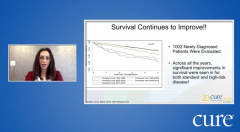
Educated Patient® Multiple Myeloma Summit MGUS/Smoldering Myeloma Presentation: March 12, 2022
Watch Dr. Neha S. Korde, an assistant professor in multiple myeloma service in the Division of Hematology at Memorial Sloan Kettering Cancer Center, present on MGUS/smoldering myeloma.
Multiple myeloma is often preceded by a precursor disease, such as monoclonal gammopathy of undetermined significance (MGUS) or smoldering myeloma. However, patients with a myeloma precursor disease may not always progress to multiple myeloma — so what should patients know about their disease?
“We do know that there are patients within the MGUS groups … as well as in this smoldering myeloma group that are at higher risk of progressing (to multiple myeloma). And so identifying those patients is important because we know that we always need to follow these patients and observe them for the rest of their lives, just to make sure they are not progressing to multiple myeloma,” said Dr. Neha S. Korde in an interview with CURE®.
Korde, an assistant professor in multiple myeloma service in the Division of Hematology at Memorial Sloan Kettering Cancer Center in New York, spoke more on this topic during CURE®’s Educated Patient® Multiple Myeloma Summit.
What Are MGUS and Smoldering Myeloma?
MGUS is one precursor to multiple myeloma and consists of a fewer number of myeloma cells in the bone marrow, Korde explained. Patients who are Black, male and older are at the highest risk for MGUS. Specifically 3% to 5% of elderly adults can have MGUS, she noted.
Patients with MGUS have about a 0.5% to 1%
Smoldering myeloma, another precursor disease, has the highest disease burden in general and the highest risk for progressing to multiple myeloma, Korde explained. Specifically, in the first three to five years of diagnosis, patients with smoldering myeloma have a 10% risk for progressing to multiple myeloma, although this risk can decrease over time.
“As you look at the spectrum of precursor disease, it goes from MGUS to smoldering. And it’s really the high-risk (smoldering patients) that we have to hone in on and make sure clinically that they’re not progressing,” Korde explained.
Korde explained that physicians look at the same risk factors in patients with smoldering myeloma among others like monoclonal spikes. Those are the models that oncologists have currently been using, but she noted that there has recently been a focus on genetics and specific mutations that may be risk factors for progression.
“This is really important because as we start to identify and stratify who’s more at higher risk of progressing, specifically the high-risk smoldering patients are at the highest risk of progressing,” Korde added. “Once we identify those patients, what we’ve been doing in the field is really trying to understand if some of those patients should be treated early or intervened upon early to delay progression to multiple myeloma.”
There are currently some
What Can Patients Do?
As of now, there is no consensus on how to address these patients with high-risk smoldering myeloma, Korde said. For those who are high risk, she typically advises this group to enroll in a clinical trial, if applicable, but that isn’t the right answer for every patient. For patients ineligible for clinical trials, the best advice is to watch and wait, Korde added.
“At this point, if you have high-risk smoldering, the right answer is, we have to watch, observe, follow your blood markers and follow, essentially, your clinical disease and see if you’re progressing. So the default answer is observation,” she said.
During observation, patients with smoldering or MGUS should be followed up with lab appointments while continuing the conversation with their provider about next steps and general check-ins throughout the journey, Korde said. Patients with MGUS are often seen as asymptomatic, so it is vital to discuss any symptoms with their physician, as it may play into the risk for progression.
“It’s always important, if you’re an MGUS patient, to always talk about all the symptoms you may be experiencing, whether it’s neuropathy, whether it’s something else, blood pressure-related or GI related. It’s always important to talk about all of that because it might fit into one of these other clinically distinct syndromes that we’re trying to characterize at the moment,” she said.
Additionally, there has been recent literature published that
“I do think that we will probably see also a resurgence of these lifestyle modification types of interventions, and that’s kind of exciting,” Korde added.
For patients who have high-risk smoldering myeloma, she recommends seeking out a couple of different expert opinions who really understand the field. Experts may recommend joining a clinical trial or observation alone but seeking out a highly specialized expert can be beneficial.
What’s Next?
Korde explained that there has been great work being done in the diagnosis of MGUS and smoldering, and really understanding who is at high risk of progressing
“I think once we see all three of these merging together — genetic mutation signatures, diagnosis testing, as well as a consensus around treatment — we will start to come up with what’s the best strategy to treat these patients,” Korde concluded.
For more news on cancer updates, research and education, don’t forget to
















